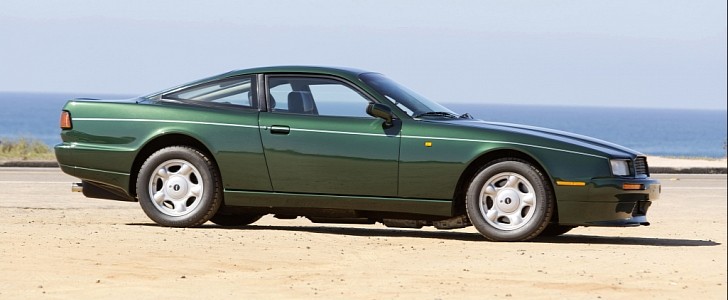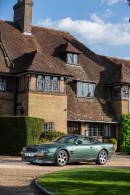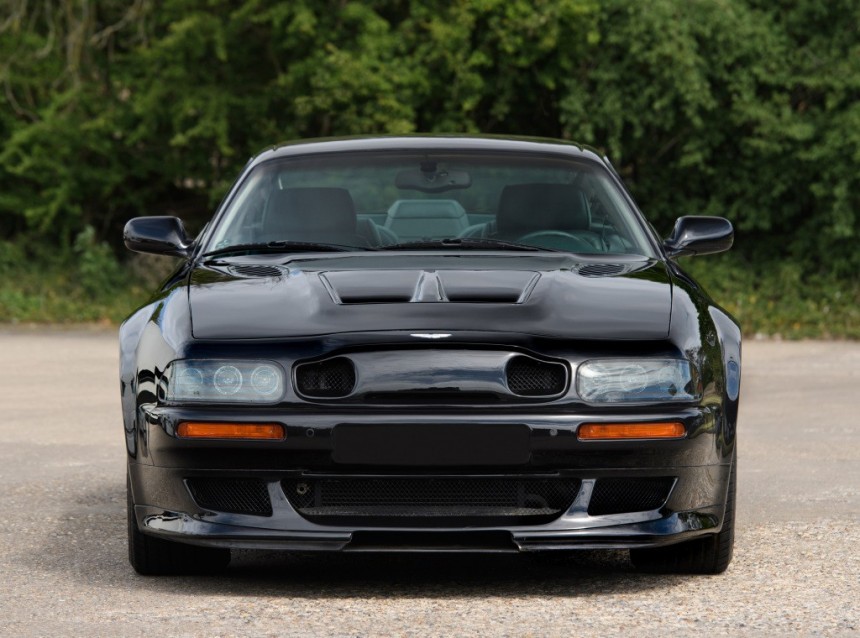As you're well aware, Aston Martin never had the financial security it rightfully deserved. The David Brown era came to an end in 1972 when William Willson of Company Developments entered the scene, followed by American businessmen Peter Sprague and British officer property developer Alan Curtis. In 1981, Sprague and Curtis sold the company to Victor Gauntlett of Pace Petroleum and Tim Hearley of CH Industrials.
Pace and CHI had to sell the ailing automaker in 1987 to Ford, but it’s under these two that Aston Martin started developing the company’s final truly hand-built car. A replacement for the original V8 lineage, the muscled-up Virage was introduced to the world at the 1988 Birmingham Motor Show.
Positioned above the six-cylinder Aston Martin DB7, the Virage and succeeding variants are tremendously collectible nowadays. Only 1,050 units were produced from 1989 through 2000, which makes it extremely rare in comparison to the aforementioned DB7 and the almighty Vanquish.
Based on a Lagonda chassis, the Virage is 306 millimeters shorter than the four-door luxury sedan and 75 millimeters longer than the old V8 series. Double wishbones up front, a de Dion rear axle, a Watts linkage, triangulated radius rods, and Bilstein dampers made the grand tourer very capable - at least for that era - in the corners. 302-millimeter disc brakes provided the stopping power up front. In stark contrast to the Lagonda, the rear disc brakes were relocated outboard to the wheels for easier servicing.
A 103-liter gasoline tank quenches the thirst of the Tadeusz "Tadek" Marek-designed V8 engine that premiered in the DBS V8 in 1969. From a displacement of 5,340 cubic centimeters, the DOHC mill with Weber Marelli electronic sequential fuel injection and Callaway-developed heads is good for 330 horsepower and 350 pound-feet (475 Nm) at 4,000 revs.
A five-speed manual developed by ZF Friedrichshafen or a Chrysler TorqueFlite three-speed automatic are tasked with shifting cogs. The row-your-own transmission with a three-pedal setup is the quicker of the two, promising 100 kilometers per hour (62 miles per hour) in merely 5.8 seconds.
Hand-beaten aluminum bodywork and fiberglass bumpers complement Audi 200-sourced headlights and Volkswagen Scirocco-sourced taillights. Muscular on the outside, the Virage was on a different level from the Lagonda and V8 on the inside, thanks to much better materials and build quality.
Although the Ford Motor Company took control of Aston Martin one year before the grand reveal of the Virage, the 2+2 sports tourer had been fitted with Ford switchgear to reduce development and production costs. But as opposed to the DB7, the Blue Oval parts don’t stick out like a sore thumb.
The Volante soft-top convertible was presented at the Birmingham Motor Show in October 1990, then Aston Martin released the 6.3-liter conversion package in January 1992. Care to guess how much this option used to retail for? Make that a cool £50,000, which is $66,360 converted at today’s exchange rates, on top of the car's base price of £135,000 ($179,180).
1,007 more cubic centimeters and the re-mapped engine management system help the free-breathing lump crank out 465 horsepower and 460 pound-feet (624 Nm) at 4,400 revolutions per minute. From a visual standpoint, the 6.3 is easily recognizable, thanks to its flared fenders.
September 1992 is when the Vantage rolled out with a twin-supercharged V8 based on the Virage’s 5.3-liter unit. Rated at 550 horsepower and 555 pound-feet (745 Nm) at 4,000 rpm, this version was further upgraded in 1998 with the V600 specification. As the name implies, V stands for Vantage and 600 designates the horsepower. It's also worth noting that Aston Martin decided to replace the Virage nameplate with V8 Coupe and V8 Volante in 1996.
The final evolution of Aston Martin’s Virage series honors the automaker’s 1959 victory at the 24 Hours of Le Mans. 40 examples of the 600-plus-horsepower V8 Vantage Le Mans were produced from 1999 to 2000 upon special commission with over-the-top exterior styling cues, a sterling silver keyholder, and a Vmax of 200 miles per hour (322 kilometers per hour).
Positioned above the six-cylinder Aston Martin DB7, the Virage and succeeding variants are tremendously collectible nowadays. Only 1,050 units were produced from 1989 through 2000, which makes it extremely rare in comparison to the aforementioned DB7 and the almighty Vanquish.
Based on a Lagonda chassis, the Virage is 306 millimeters shorter than the four-door luxury sedan and 75 millimeters longer than the old V8 series. Double wishbones up front, a de Dion rear axle, a Watts linkage, triangulated radius rods, and Bilstein dampers made the grand tourer very capable - at least for that era - in the corners. 302-millimeter disc brakes provided the stopping power up front. In stark contrast to the Lagonda, the rear disc brakes were relocated outboard to the wheels for easier servicing.
A 103-liter gasoline tank quenches the thirst of the Tadeusz "Tadek" Marek-designed V8 engine that premiered in the DBS V8 in 1969. From a displacement of 5,340 cubic centimeters, the DOHC mill with Weber Marelli electronic sequential fuel injection and Callaway-developed heads is good for 330 horsepower and 350 pound-feet (475 Nm) at 4,000 revs.
A five-speed manual developed by ZF Friedrichshafen or a Chrysler TorqueFlite three-speed automatic are tasked with shifting cogs. The row-your-own transmission with a three-pedal setup is the quicker of the two, promising 100 kilometers per hour (62 miles per hour) in merely 5.8 seconds.
Although the Ford Motor Company took control of Aston Martin one year before the grand reveal of the Virage, the 2+2 sports tourer had been fitted with Ford switchgear to reduce development and production costs. But as opposed to the DB7, the Blue Oval parts don’t stick out like a sore thumb.
The Volante soft-top convertible was presented at the Birmingham Motor Show in October 1990, then Aston Martin released the 6.3-liter conversion package in January 1992. Care to guess how much this option used to retail for? Make that a cool £50,000, which is $66,360 converted at today’s exchange rates, on top of the car's base price of £135,000 ($179,180).
1,007 more cubic centimeters and the re-mapped engine management system help the free-breathing lump crank out 465 horsepower and 460 pound-feet (624 Nm) at 4,400 revolutions per minute. From a visual standpoint, the 6.3 is easily recognizable, thanks to its flared fenders.
September 1992 is when the Vantage rolled out with a twin-supercharged V8 based on the Virage’s 5.3-liter unit. Rated at 550 horsepower and 555 pound-feet (745 Nm) at 4,000 rpm, this version was further upgraded in 1998 with the V600 specification. As the name implies, V stands for Vantage and 600 designates the horsepower. It's also worth noting that Aston Martin decided to replace the Virage nameplate with V8 Coupe and V8 Volante in 1996.
The final evolution of Aston Martin’s Virage series honors the automaker’s 1959 victory at the 24 Hours of Le Mans. 40 examples of the 600-plus-horsepower V8 Vantage Le Mans were produced from 1999 to 2000 upon special commission with over-the-top exterior styling cues, a sterling silver keyholder, and a Vmax of 200 miles per hour (322 kilometers per hour).































